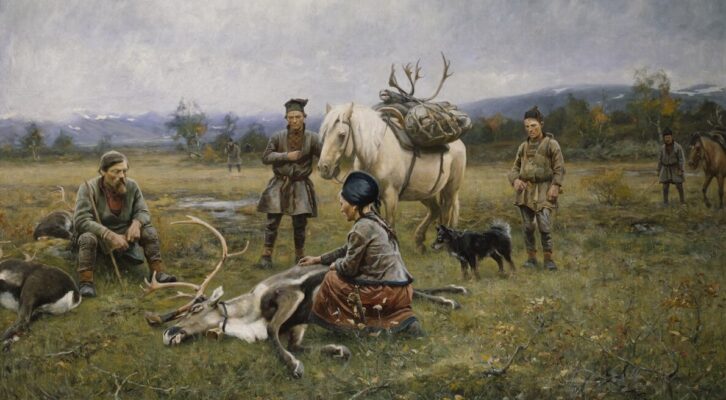
An Overdue Reckoning: How Sweden Continues to Deny Its Settler-Colonial Past
Linnea Axelsson on Scandinavia’s Hidden History of Indigenous Oppression
For the past decades, the two communities of which I am a part—Sámi, from the part of Sápmi that falls within Sweden’s borders, and the Swedish majority society—have been developing in different directions. The former is making an effort to take a close look at history in order to slowly move towards greater openness. However, large parts of the latter seem to be rewriting history as a pure fantasy of Swedishness. In doing so the Swedish majority society is closing itself off to the outside world.
Among Sámi organizations, in everyday encounters and elsewhere, there is a palpable desire to do away with the cultural stereotypes to which we ourselves have been reduced—that is, ideas about what the Sámi people are and can be as shaped by centuries of colonialism. Unfortunately many of Sweden’s leading politicians are busy working towards another end.
As if fever-driven, they’re constructing the image of a Swedish ur-nation inhabited by a single homogenous people, a nation now being ravaged by foreign, inferior cultures. This imagined endangered, original Swedish society does a good job of concealing the reality of Sweden today—the vast gaps between the social classes, the alienation and gang violence that rose alongside the dismantling of the welfare state. (Decade upon decade, Sweden’s supportive structures have been eroded, along with the citizenry’s power to influence them. The deregulated Swedish school system may be the gravest example.)
From a Sámi perspective, Sweden is a nation that will still only confess to “historical oppression” and “abuse” in order to avoid looking at itself in the mirror and having to use the word “colonialism.”
At the crux of this is the Western attitude that uses cultural supremacy to justify its plundering.
Sámi society, which weaves through Norway, Sweden, Finland and Russia, differs from these nation-states in a number of ways. A fundamental distinction is how the culture and some of its means of livelihood are in various ways connected to and predicated upon on reindeer husbandry, a way of life that has survived despite settler colonialism, despite the ongoing climate crisis and despite the rift between the Sámi people caused by the state regulation of reindeer husbandry.
There have been a number of recent editorial in Dagens Nyheter, Sweden’s largest daily newsletter, one of which gets to the crux of the rift between Sámi who herd reindeer and those who do not, an artificial distinction asserted by the Swedish state when it drafted the current legal framework for reindeer husbandry and did so without any knowledge and consideration of or interest in Sámi society’s own structure and modes of cooperation.
It is this piece of legislation that divided the Sámi into two groups: reindeer herders and non-reindeer herders. True Sámi, per this framework, were reindeer-herding Sámi from the mountains and to be protected from civilization. All other Sámi would be forcibly assimilated into Swedish society; they were to become Swedes and forget their language, culture and traditions; the reindeer husbandry laws have thus not only caused a rift in Sámi society, but have also reached inside the individual, into their sense of identity, belonging and value.
The reindeer-herding Sámi gather in samebyar, or Sámi villages, which are not villages per se but an economic and administrative union in a geographical area where members have the right to engage in reindeer herding, and there the total amount of reindeer is regulated by the state. Each new member inducted into a Sámi village must be given a share of the pre-allocated number of reindeer, which are to coexist on land that is also being used by mining, forestry and wind power industries.
Information about this chapter in Swedish-Sámi history is readily available, yet none of these articles describe how the eye of this needle came to be and is to this day maintained by colonial politics. Instead the journalist portrays herders as part of a malicious club working against their own interests and the interests of all other Swedes, and who, through through legal finagling, are trying to assert their claim on more than half of Sweden’s land.
Furthermore, herders are portrayed as a threat to outdoor life in Swedish national parks, despite the fact these parks were often established on traditionally indigenous land where people are already working, living, and gathering medicine and materials and food—land that visitors are invited to “discover” as a beautiful wilderness with excellent opportunity for recreation.
A decade after the area around Stora Sjöfallet (or The Great Falls, also once called the “Niagara Falls of the North”), the region I come from, was designated as a national park, its status as a site of natural preservation was simply revoked so that the associated river could be further regulated to better supply the electrical grid. The eponymous great waterfall is now but a memory. Even so, it is the Swedish state that is asserted as the protector of these lands, not the Sámi herders. As some would have it, these Sámi can hardly be said to steward their land anymore, now that they’ve started using motorized vehicles to get around.
Here is an echo of a time when indigenous cultures were to be shielded from modernity, to be “preserved” as if in a bell jar. When, in addition to skis, snowmobiles are added to the equation, a Sámi is said to be forsaking tradition; but if a Sámi uses only skis, they are considered primitive and incapable of adapting to the modern world.
When I try to put my finger on what about these texts is unsettling, I end up pointing to their intentions: the choice of angle and information. If you aim for the truth but insist on placing the scope just off-center, you end up with a skewed shot. Thus, by consistently choosing to ignore history, indigenous people fighting for their rights are transformed into a greedy minority fighting for special privileges. And this reframing takes place under the guise of scrutinizing said “privileges,” instead of openly declaring what lies at the core of the endeavor: the opinion that colonialization was the correct path because it has benefited Sweden.
Sápmi has begun its reckoning, but Sweden continues to look away.
These editorials hold a bitter brew. They have a particular way of turning a deaf ear to history and simply describing the situation as the writer would prefer it to be, an impulse that can also be observed in those who hold power and sway the world over. Also at the crux of this is the Western attitude that uses cultural supremacy to justify its plundering, reasoning that the value of nature is purely monetary, down to the last tree, the last fish, the last stream, and insisting that one is being superior to all others in every way, rather than imagining that we have something to learn from each other.
A culture like this, by definition, can never see itself as a colonizer. This culture has a grand plan of constant improvement, and every related project and strategy is worth the cost. A culture like this will never comprehend the paradox of wanting to destroy nature in order to save nature, which is what “the green transition” is all about. This plan for a greener future is just more of the same. Civilization will continue as usual, but will now be plugged into a new, green grid. (As if it is a foregone conclusion that we want even more mines. After all, in these new mines other metals will be mined than were being mined before!) And at the heart of all this, of course, is the same old dirty story of money. Had Sápmi not been located in a part of Sweden full of forests, minerals and rivers, this situation would look very different.
The grand history of nation-states is inevitably a history of lies and theft and formidable powers of imagination, as well as varying degrees of coercion and death. Nothing is easy about renegotiating one’s self-perception. Sápmi has begun its reckoning, but Sweden continues to look away. Sweden does look to the past, but with a false, nostalgic gaze. Its vision of history can only lead the country into a narrow and isolated future.
__________________________________

Aednan: An Epic by Linnea Axelsson, translated by Saskia Vogel is available from Alfred A. Knopf, an imprint of Knopf Doubleday Publishing Group, a division of Penguin Random House. Featured image: “Sami Collecting Reindeer Which Have Been Shot,” by Johan Tirén (1892).
Linnea Axelsson
Linnea Axelsson is a Sámi-Swedish writer, born in the province of North Bothnia in Sweden. In 2009, she earned a Ph.D, in art history from Umeå University. In 2018, she was awarded the August Prize for this book. She lives in Stockholm, Sweden.



















